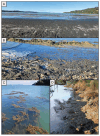First Report of Accumulation of Lyngbyatoxin-A in Edible Shellfish in Aotearoa New Zealand from Marine Benthic Cyanobacteria
- PMID: 39728780
- PMCID: PMC11728527
- DOI: 10.3390/toxins16120522
First Report of Accumulation of Lyngbyatoxin-A in Edible Shellfish in Aotearoa New Zealand from Marine Benthic Cyanobacteria
Abstract
This study reports the first documented accumulation of lyngbyatoxin-a (LTA), a cyanotoxin produced by marine benthic cyanobacteria, in edible shellfish in Aotearoa New Zealand. The study investigates two bloom events in 2022 and 2023 on Waiheke Island, where hundreds of tonnes of marine benthic cyanobacterial mats (mBCMs) washed ashore each summer. Genetic analysis identified the cyanobacterium responsible for the blooms as Okeania sp., a genus typically found in tropical marine ecosystems. Analysis by liquid chromatography-tandem mass spectrometry indicated that the cyanobacteria produced a potent dermatoxin, lyngbyatoxin-a (LTA), and that LTA had accumulated in marine snails, rock oysters and cockles collected near the mats. Snails contained the highest levels of LTA (up to 10,500 µg kg-1). The study also demonstrated that the LTA concentration was stable in composted mats for several months. The presence of LTA in edible species and its stability over time raise concerns about the potential health risks to humans consuming LTA-contaminated seafood. This underlines the need for further studies assessing the risks of human exposure to LTA through seafood consumption, particularly as climate change and eutrophication are expected to increase the frequency of mBCM blooms. The study highlights the need to develop public health risk management strategies for mBCMs.
Keywords: bioaccumulation; cyanoHAB; degradation; food safety; harmful algal blooms; liquid chromatography–tandem mass spectrometry; marine cyanotoxins; public health risk; toxicity.
Conflict of interest statement
The authors declare no conflicts of interest.
Figures






Similar articles
-
Transfer of microcystin from freshwater lakes to Puget Sound, WA and toxin accumulation in marine mussels (Mytilus trossulus).Ecotoxicol Environ Saf. 2015 Dec;122:98-105. doi: 10.1016/j.ecoenv.2015.07.013. Epub 2015 Jul 25. Ecotoxicol Environ Saf. 2015. PMID: 26218554
-
Microcystin contamination of shellfish along the freshwater-to-marine continuum within US mid-Atlantic and Northeast estuaries.Harmful Algae. 2025 May;145:102860. doi: 10.1016/j.hal.2025.102860. Epub 2025 Apr 8. Harmful Algae. 2025. PMID: 40324861
-
A Fast Detection Strategy for Cyanobacterial blooms and associated cyanotoxins (FDSCC) reveals the occurrence of lyngbyatoxin A in campania (South Italy).Chemosphere. 2019 Jun;225:342-351. doi: 10.1016/j.chemosphere.2019.02.201. Epub 2019 Mar 8. Chemosphere. 2019. PMID: 30884295
-
Shellfish and residual chemical contaminants: hazards, monitoring, and health risk assessment along French coasts.Rev Environ Contam Toxicol. 2011;213:55-111. doi: 10.1007/978-1-4419-9860-6_3. Rev Environ Contam Toxicol. 2011. PMID: 21541848 Review.
-
Emerging health issues of cyanobacterial blooms.Ann Ist Super Sanita. 2012;48(4):415-28. doi: 10.4415/ANN_12_04_09. Ann Ist Super Sanita. 2012. PMID: 23247138 Review.
References
-
- Acevedo-Trejos E., Brandt G., Steinacher M., Merico A. A glimpse into the future composition of marine phytoplankton communities. Front. Mar. Sci. 2014;1:15. doi: 10.3389/fmars.2014.00015. - DOI
-
- Hallegraeff G.M. Harmful algal blooms: A global overview. Man. Harmful Mar. Microalgae. 2003;33:1–22.
Publication types
MeSH terms
Substances
Grants and funding
LinkOut - more resources
Full Text Sources

